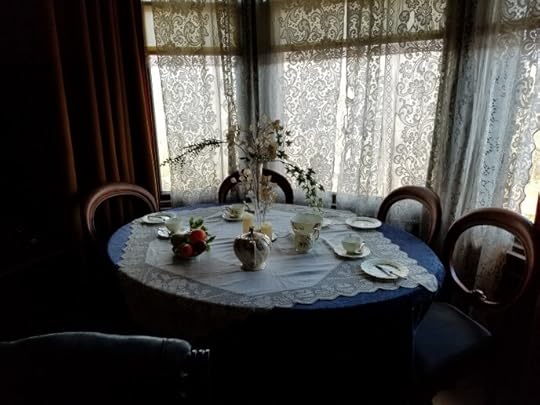Connie Berry's Blog
March 31, 2019
Castles & Kooks
 Throne chair in royal palace, Stirling Castle, Stirling, Scotland
Throne chair in royal palace, Stirling Castle, Stirling, ScotlandScotland boasts some of the world’s most romantic castles. Maybe you’ve had the privilege of visiting one: Edinburgh, Dunvegan, Urquhart, Holyrood, Eilean Donan, Glamis. The names alone conjure the passion and power of clans and kings.

Of all Scotland’s castles, however, Stirling Castle wins the prize for the most eccentric resident. Sometime around the year 1500, John Damian, a penniless adventurer of either Italian or French origin, arrived at Stirling Castle, claiming to be an alchemist, on the verge of discovering the secret of turning base metals into gold.
 UNITED KINGDOM – CIRCA MARCH, 2010: A stamp printed by GREAT BRITAIN shows image portrait of King of Scotland James IV
UNITED KINGDOM – CIRCA MARCH, 2010: A stamp printed by GREAT BRITAIN shows image portrait of King of Scotland James IVFortunately for Damian, King James IV–arguably the most successful of the Stewart monarchs–was keenly interested in the new scientific discoveries of the Renaissance. He was even more interested in possessing an inexhaustible source of gold to fund his frequent military campaigns. And wealth wasn’t the only blessing John Damian promised. Not only would he produce the most sought-after object of his day, the Philosopher’s Stone–that mythical and magical substance needed to transform lead into gold–but he also offered the king an even more precious prize. The Philosopher’s Stone, when mixed with wine, was said to produce the Elixir of Life, curing all illnesses and granting the drinker eternal life and youth. Not bad, right?
 Ancient alchemist’s workshop with instruments and equipment
Ancient alchemist’s workshop with instruments and equipmentWith these tantalizing possibilities in mind, King James IV provided John Damian with a hidden laboratory in the castle, along with such luxuries as damask fabric for clothing, a fine bed, tapestries, plenty of “aqua vitae” (whiskey), and all the equipment–flasks, cauldrons, glass, and chemicals–he needed to conduct his experiments.

When years passed and no gold was forthcoming, court gossips began whispering about fraud. Damian, sensing that a spectacular demonstration of his powers was called for, announced he had discovered the secret of mechanical flight. On September 27, 1507, he strapped on a pair of bird-like wings and leapt off the highest tower of Stirling Castle. He dropped like a stone. Lucky for him, he landed (so the story goes) on a dung heap, breaking only a thigh bone. Damian blamed the failure on the castle poulterers who had mixed hen feathers in with the eagle feathers he had called for–and we all know hens can’t fly.
James must have bought the story for he continued to fund Damian’s “research,” right up until his own death in 1513 at the Battle of Flodden. And John Damian disappeared.
Do you have a favorite castle? A favorite legend? I’d love to hear about it!
The post Castles & Kooks appeared first on Connie Berry.
March 26, 2019
Scottish Time Travel?
 The resident of Mrs. and Miss Toward, 143 Buccleuch Street, Glasgow
The resident of Mrs. and Miss Toward, 143 Buccleuch Street, GlasgowThanks to the mega-hit Outlander, it’s impossible to wander through the Scottish Highlands without thinking of standing stones and portals to the past. But that’s not what I’m writing about today. Scientists have yet to find a pathway back in time. The past, however, occasionally travels forward in time to visit us. The first time I encountered this phenomenon I was a child, riding on a public bus in Buffalo, New York, with my Scottish grandmother. The bus pulled to a stop outside a florist’s shop. The front window featured a badly faded Easter display even though it was late August. And all the flowers were dead. “Why are the flowers black?” I asker her. “Ah, well,” she answered, “the day his wife died, poor man–years ago this was–he locked the doors and never stepped inside again. Everything is exactly as he left it that terrible day.”
I’m sure I inherited my affinity for the macabre from my grandmother. The fact that the flower shop was frozen in time fascinated me. Stepping inside, I thought, would be like time travel.
I had the same experience in Glasgow last week when my husband and I visited the National Trust for Scotland’s “Tenement House” at 145 Buccleuch Square in Glasgow’s city center. The two-room-and-a-kitchen flat on the second floor of a tenement block built in 1892 was lived in by Mrs. Toward, a widowed dressmaker, and her only daughter, Agnes, a typist. After Mrs. Toward’s death, Agnes continued to occupy the flat in genteel poverty until her own death in 1972–a total of 54 years. Here’s the amazing part: not only was Agnes a bit of a hoarder and a person who couldn’t see the wisdom in updating what was working perfectly well; she also spent the final 10 years of her life in the hospital, leaving the flat exactly as it was the day she left.

After her death when the rent ceased to be paid, the property manager decided to clear the place and modernize it for new tenants. But first an elderly man who’d helped Miss Toward in her later years showed up to claim six dining room chairs she’d left him in her will. With him was his niece, the actress Anna Davidson. This is how she described that day: “I felt like Pip in the film of Great Expectations when he stood at the door of Miss Havisham’s room. Under layers of dust Miss Toward’s flat was exactly as it had been ten years earlier when the door closed behind her for the last time. The box bed in the kitchen was covered with cobwebs, but the stone hot water bottle was still between the sheets. There was washing on the pulley suspended from the ceiling, coal in the wooden bunker, jars of jam in the cupboards, and unwashed iron pans on the cooking range….I knew I just had to save all this for posterity and I decided then and there to buy the flat–although I already had a place of my own (as told to Margaret Henderson, in the blog Scotiana: Everything Scottish, 2015).”


Anna lived in the flat for seven years, scrubbing, polishing, and restoring it to its original condition. In 1982 the National Trust for Scotland purchased the flat with the intention of opening it to the public. The only major change they made was to restore the gas lighting. They opened the doors in 1983. Last week my husband and I had the privilege of entering Miss Toward’s private world. Time travel.

If you could travel to any period and place in history, where would you go–and why? Would you right a wrong or just observe? And one more thing: I’ve never found anyone who remembers that florist’s shop in Buffalo, New York. If you live in that area and remember anything, please let me know!
The post Scottish Time Travel? appeared first on Connie Berry.
December 16, 2018
The Joys of Winter
As I write, I look out on a thick blanket of snow rolling down to a frozen white lake. Ice fog blurs the landscape. The temperature outside is 7° F. The snow lies at a depth of 12 inches, and more is on the way. Our cottage in northern Wisconsin is in the path of another storm. I say, bring it on.
Come mid-December, when many Ohioans dream of white sand beaches or the warm hues of the desert, my husband and I head north. Far north. Give me a white Christmas, please. Up here in ski- and snow-mobile territory, “Let it Snow” is the winter motto. I wouldn’t mind going farther north. Near the top of my travel “bucket list” is a stay at one of the  fabulous ice hotels in Scandinavia, although I’d settle for the one in Quebec.
fabulous ice hotels in Scandinavia, although I’d settle for the one in Quebec.
I’ve always been a winter lover. A November baby. Born in the Danish settlement of Racine, Wisconsin. Every day, so I’m told, my mother bundled me in my pram and rolled me outside on the porch for an hour or so.  It was supposed to keep me strong and healthy. In Scandinavia women still put their babies outside in sub zero weather. That’s where they get those pink cheeks.
It was supposed to keep me strong and healthy. In Scandinavia women still put their babies outside in sub zero weather. That’s where they get those pink cheeks.
I love mystery novels set in cold climates, too. One of my favorites, Charles Todd’s A Cold Treachery, is set in December of 1919. Scotland Yard Inspector Ian Rutledge is sent out in a violent blizzard to investigate the murder of a sheep-farming family in a remote village England’s Lake District. So effectively did the authors [Charles Todd is a mother-son writing team] use sensory details to create the bitterly cold world of the novel that all I have to do now is think about the story and I want to curl up in front of a fire with a mug of hot tea. After all, the joys of winter include such things as a blazing fire, warm sweaters, flickering candles, and steaming hot drinks. Merry Christmas!
details to create the bitterly cold world of the novel that all I have to do now is think about the story and I want to curl up in front of a fire with a mug of hot tea. After all, the joys of winter include such things as a blazing fire, warm sweaters, flickering candles, and steaming hot drinks. Merry Christmas!
Check out my Pinterest board, The Joys of Winter.
The post The Joys of Winter appeared first on Connie Berry.
November 27, 2018
A Scottish Christmas
 MY DEBUT NOVEL, A Dream of Death, will be published by Crooked Lane Books in April of 2019. The setting, a fictional island in the Inner Hebrides, reflects the metaphoric “island” in Buffalo, New York, where my Scottish grandparents immersed themselves in all things Scottish and dreamt of the “auld country.”
MY DEBUT NOVEL, A Dream of Death, will be published by Crooked Lane Books in April of 2019. The setting, a fictional island in the Inner Hebrides, reflects the metaphoric “island” in Buffalo, New York, where my Scottish grandparents immersed themselves in all things Scottish and dreamt of the “auld country.”
To celebrate, I’m posting two special Scottish recipes, the first from my grandmother and the second from her best friend. Both are amazing and straight from early 1900s Scotland.
Flora Campbell’s Christmas Yum-Yum Cake1-1/2 c. large seeded raisins
1 c. dates, cut up
1 c. dried prunes, cut up
2 c. sugar
2 c. boiling water
5 T. butter
The night before: Put this on to boil. Simmer gently for 20 minutes. Cool.
In the morning add:
3-1/2 c. sifted flour
1/2 t. baking soda
2 t. cinnamon
1 t. cloves
1 t. salt
1/2 c. nuts (any kind; optional)
Mix with a wooden spoon, transfer to a loaf pan, and bake 1 to 1-1/2 hours at 350 degrees. Cool completely before slicing
Meg Murchie’s Scottish Scones2 c. flour
1/2 t. salt
1 t. cream of tartar
3/4 t. baking soda (level)
1 t. baking powder
2 dessert spoons of sugar (about a tablespoon)
2 dessert spoons of butter (about a tablespoon)
1 beaten egg
1 c. buttermilk
Mix dry ingredients. Rub in shortening with fingertips. Add beaten egg and buttermilk. Halve the dough and cut into four pieces. Bake on lightly oiled griddle.
The post A Scottish Christmas appeared first on Connie Berry.
November 22, 2018
per•se•ver•ance
noun \ˌpər-sə-ˈvir-ən(t)s\ First known use: 14th century
:The quality that allows someone to continue trying to do something even though it is difficult : Continued effort to do or achieve something despite opposition : Steady persistence in a course of action
“What is written without effort is in general read without pleasure.” Samuel Johnson, Johnsonian Miscellanies, Vol 2.
About a year and a half ago, a friend and successful mystery writer told me, “Writing a novel takes persistence. And when you think you’re done, you’re probably not.”
That wasn’t what I wanted to hear at the time. But she was right. And as I slog my way through the fourth major revision of my manuscript, I tell myself that I may not be at the end of the process yet, but I am drilling down toward the goal, and that’s what counts.
One source of encouragement is the experience of others. Most successful writers will admit to a flood of rejection letters. Some stories are legendary. Here’s a sampling:
Agatha Christie endured five years of rejection before publishing The Mysterious Affair at Styles, featuring the little Belgian detective, Hercule Poirot.C. S. Lewis, author of The Narnia Chronicles, received over 800 rejections before he published a single piece of writing.William Faulkner received this rejection letter: “If the book had a plot and structure, we might suggest shortening and revisions, but it is so diffuse that I don’t think this would be of any use.”J. K. Rowling’s Harry Potter & The Sorcerer’s Stone was rejected repeatedly until the eight-year-old daughter of an editor demanded to read the rest of the book. Dr. Seuss was told about his first book, And To Think That I Saw It on Mulberry Street, “too different from other juveniles on the market to warrant its selling.”Louisa May Alcott was told to stick to teaching.Madeleine L’Engel‘s classic A Wrinkle in Time was turned down 26 times before it was published.George Orwell was told of Animal Farm, “It is impossible to sell animal stories in the USA.”Louise Penny, author of the Gamache mystery series set in Canada (and one of my favorite mystery writers), says her first mystery Still Life was turned down more times than she was willing to admit, even to her agent.Last year more than 400,000 people took part in National Novel Writing Month (NaNoWrMo). The annual event challenges participants to write 50,000 words of a new novel during the month of November. Every year hundreds of thousands of novels are begun. A much smaller number are completed. But are they finished? What does it mean to be finished? What does it take?
Taking a novel from the first word to publishable form takes many things: talent, time, effort, a little bit of luck, friends, the ability to receive and profit from criticism, endless revisions, more criticism, more revisions.
And perseverance.
The post per•se•ver•ance appeared first on Connie Berry.
November 17, 2014
My New Best Friends
 A recent post on the Jungle Red Writers’ Blog, “On Killing Rachel,” (http://www.jungleredwriters.com/2014/11/on-killing-rachel.html) reminded me of my three new best friends
A recent post on the Jungle Red Writers’ Blog, “On Killing Rachel,” (http://www.jungleredwriters.com/2014/11/on-killing-rachel.html) reminded me of my three new best friends
No one has been more faithful to me than these three, often calling several times a day. No one shows more friendly enthusiasm and genuine concern for my welfare. Of course, the fact that I’ve never met them is a bit worrisome.
Do you think I’m being stalked?
The first (and most persistent) of my faithful friends is Brigitte from Card Holder Services. She worries that I’m paying too much interest on my credit card. Actually I never pay interest on my credit card, but Brigitte is still concerned–so concerned that sometimes, when Brigitte is busy, she asks her friend Rachel to call me. Now I don’t condone lying, but I must confess I am sorely tempted to give her bogus information. Just to put her mind at rest, you understand.
Another faithful friend is Richard from India. Sometimes he calls himself by another name, but I know it’s him. He works for “Microsoft Technical Department” (impressive, right?), and he thinks I may have a computer virus. He wonders if I’m online and offers to take control of my system and eliminate a virus infection. I hate to be skeptical, but I sometimes wonder if Richard really has my best interests at heart. Once I told him he sounded like a nice person, but I was pretty sure he was trying to scam me. Was he offended? Not a bit. He was encouraged.
My third faithful friend (and the newest) is Carla. She thinks I’ve been working too hard and wants to give me a free cruise. I may take her up on it.
The post My New Best Friends appeared first on Connie Berry.
July 30, 2014
Dream, Dream, Dream
 The main character in my mystery, young widow Kate Hamilton, contemplates the significance of dreams:
The main character in my mystery, young widow Kate Hamilton, contemplates the significance of dreams:
All you have to do is dream, the Everly Brothers promised. If only it were that simple. She’d never once dreamt of Bill, though she’d often tried—poring over old photographs, pulling up memories. All she had now were memories and an empty bed.
Have you ever wished for a dream or tried to dream about something? Experts say that dreams express what is on our minds. Dreams are stories we tell ourselves. So, in theory, if we fill our minds with something before bedtime, we should dream about it, right? In my experience it doesn’t work that way.
Do you remember your dreams? My husband claims not to remember them. I usually do, often in great detail. Some dreams are common to people all over the world. Here’s how four universal dreams manifest themselves in the western world:
* The School Dream (Unpreparedness)
It’s time for final exams, and you realize you’ve forgotten to attend any of the
classes. Or all your books are in your locker, and you can’t remember the
combination.
* The Flying Dream (Aspirations)
You have the ability to fly or to float above the ground. In my version, it’s
not so much flying as “treading air.” And I can surf down a staircase in a
single bound. Now that’s fun.
* The Clothing Dream (Inadequacy, Embarrassment)
You leave the house for the day, only to discover that you haven’t put on
quite enough clothing. Yikes.
* The Chase Dream (Fear)
Someone is chasing you, but you’re running through molasses. Or you’re
stuck in slow motion.
* The Repeated Act Dream (Frustration)
There’s something you must do, like phone someone. But you keep
misdialing. You try again and again but never succeed.
“A dream is a wish your heart makes,” Cinderella famously sang in Disney’s classic movie. Dreams often express our hidden desires or fears. The famous opening line in Daphne Du Maurier’s Rebecca is an example: “Last night I dreamt I went to Manderley again.” When my husband and I were raising children and unable to travel, I often dreamt I was in Europe. Sometimes, in the dream, I’d wonder if I was dreaming, so I’d pinch myself and think, “Nope, this time I’m really here.”
People dream differently. Some dreams are quite realistic. Others are bizarre—new worlds in which the laws of nature are suspended. Some people even dream in symbols or metaphors. A friend of mine, on the eve of sending her oldest child off to college, dreamt that her daughter was literally tied to her apron, and she had to get a giant scissors to cut the string. In the Bible, God often spoke to people in dreams. Some people think He still does. The Apostle Paul, for example, was trying to take the Gospel north and east until he was redirected by the vision of a man saying (Acts 16:9), “Come over to Macedonia and help us.” He woke up, and the Gospel went west to Europe.
Some dreams are hard to shake off. Another friend dreamt once that her very sweet husband had done something really mean. The next day she had a hard time forgiving him. Who hasn’t woken from a dream, relieved that it isn’t real, and yet the memory and emotions persist? Sometimes dreams are so wonderful that we hope to pick up where we left off the next night. Never happens.
Many people have repeated dreams. Here are two of mine.
1. The Teaching Nightmare
For twenty-four years I’ve taught a large women’s Bible study during the school year. Every year in August I have my teaching nightmare. Usually it’s the first day of class, and I’ve forgotten to prepare a lecture. Or I’ve forgotten to get leaders. Or we’ve changed meeting locations, but I don’t know where. Once I dreamt that my lecture notes fell off the podium, and I just couldn’t get them back in order so everybody had to go home. I’ve had the dream so often now, I laugh about it.
2. The Sub-Human People Dream (weird alert)
Just had this one two nights ago. I come upon colonies of people who aren’t quite human and have sub-human intelligence but their own culture. They look like people except they’re a funny color and sort of triangular shaped with tapering heads on which they wear colorful striped hats resembling a Turkish fez. They’re not scary. Just strange and fascinating. And they have a name which I never can remember when I’m awake. Something like “Mosers.”
Last week I read a blog listing the “Top Ten Ways Not to Begin Your Novel.” Number 4 was waking up from a dream. Maybe, like the famous final episode of The Bob Newhart Show, it’s a better way to end.
Do you have interesting or unusual dreams? Repeated dreams? I’d love to hear about them.
The post Dream, Dream, Dream appeared first on Connie Berry.
May 21, 2014
The Last Man Who Knew Everything
Has anyone ever known everything there was to know? Who was the last person to have read every book in existence? Believe it or not, this is a hotly debated question in certain academic circles. Several names are commonly proposed.
 Greek philosopher and scientist ARISTOTLE (384 – 322 B.C.) is said to have known everything there was to be known in his time. Tutor to the youthful Alexander the Great, Aristotle’s own writings cover a virtual encyclopedia of Greek knowledge. But could he read other languages? Was he familiar with the “Hundred Schools of Thought” from the Eastern Zhou Dynasty (770-256 B.C.) of China, for example? Did he know the ancient Hebrew Scriptures, not translated into Greek until fifty years after his death? Had he read the Epic of Gilgamesh (700 B.C.), fragments of which were discovered in the library ruins of Assyrian king Ashurbanipal? It seems unlikely. To read a book, one must not only know its language; one must know it exists.
Greek philosopher and scientist ARISTOTLE (384 – 322 B.C.) is said to have known everything there was to be known in his time. Tutor to the youthful Alexander the Great, Aristotle’s own writings cover a virtual encyclopedia of Greek knowledge. But could he read other languages? Was he familiar with the “Hundred Schools of Thought” from the Eastern Zhou Dynasty (770-256 B.C.) of China, for example? Did he know the ancient Hebrew Scriptures, not translated into Greek until fifty years after his death? Had he read the Epic of Gilgamesh (700 B.C.), fragments of which were discovered in the library ruins of Assyrian king Ashurbanipal? It seems unlikely. To read a book, one must not only know its language; one must know it exists.
If we limit our search to the Western world, then, we might consider Dutch theologian and humanist, DESIDERIUS ERASMUS (1466 – 1536).  One of the last scholars prior to the impact of the printing press, Erasmus mastered all the European and Scandinavian languages of his day plus Latin, Greek, and Hebrew. Erasmus is reputed to have said, “When I get a little money I buy books; and if any is left I buy food and clothes.” But did he accumulate enough money in his lifetime to purchase every book he was capable of reading?
One of the last scholars prior to the impact of the printing press, Erasmus mastered all the European and Scandinavian languages of his day plus Latin, Greek, and Hebrew. Erasmus is reputed to have said, “When I get a little money I buy books; and if any is left I buy food and clothes.” But did he accumulate enough money in his lifetime to purchase every book he was capable of reading?
 LEONARDO DA VINCI (1452 – 1519) is perhaps history’s most recognizable polymath (Latin for “having learned much”). Painter, sculptor, architect, musician, mathematician, engineer, inventor, anatomist, geologist, cartographer, botanist, and writer, DaVinci’s genius epitomized the Renaissance humanist ideal. His interests were certainly wide-ranging, but did they extend to the intricacies of lace making? Had he studied the history of board games? In a pinch, could he have acted as midwife?
LEONARDO DA VINCI (1452 – 1519) is perhaps history’s most recognizable polymath (Latin for “having learned much”). Painter, sculptor, architect, musician, mathematician, engineer, inventor, anatomist, geologist, cartographer, botanist, and writer, DaVinci’s genius epitomized the Renaissance humanist ideal. His interests were certainly wide-ranging, but did they extend to the intricacies of lace making? Had he studied the history of board games? In a pinch, could he have acted as midwife?
The English poet JOHN MILTON (1608 – 1674), some claim, read virtually every book ever written and knew enough about most things to discuss them with authority. My son has a friend who can do the same.
some claim, read virtually every book ever written and knew enough about most things to discuss them with authority. My son has a friend who can do the same.
 JOHANN WOLFGANG von GOETHE (1749 – 1832), author of the epic play Faust, is often called “the last universal genius.” Genius he may have been, but one questions his wisdom. At the age of seventy four, Goethe fell hopelessly in love with beautiful nineteen-year-old Ulrike von Levetzow, who—not surprisingly—rejected him. “Old enough to know better” springs to mind.
JOHANN WOLFGANG von GOETHE (1749 – 1832), author of the epic play Faust, is often called “the last universal genius.” Genius he may have been, but one questions his wisdom. At the age of seventy four, Goethe fell hopelessly in love with beautiful nineteen-year-old Ulrike von Levetzow, who—not surprisingly—rejected him. “Old enough to know better” springs to mind.
Surprisingly, the name most often cited as the last person to have read every book existing in his day is the English poet SAMUEL TAYLOR COLERIDGE (1772 – 1834).  A little logic proves this impossible. The first pages flew off the Gutenberg press around 1470. By 1700 there were already millions of books in print. To read a million books in a lifetime, you would have to read forty books a day for seventy years. Leaving no time for other things, like writing poetry. And sleeping.
A little logic proves this impossible. The first pages flew off the Gutenberg press around 1470. By 1700 there were already millions of books in print. To read a million books in a lifetime, you would have to read forty books a day for seventy years. Leaving no time for other things, like writing poetry. And sleeping.
Sometime after 1700 people began to admit that the body of “known knowledge” [is there such a thing, one wonders, as “unknown knowledge”?] had become so large that it was no longer possible for one person to know everything. In his Collective Intelligence (1994), French philosopher Pierre Levy argues that the publication of Denis Diderot and Jean d’Almbert’s Encyclopedie (1751 – 1772) marks “the end of an area in which a single human being was able to comprehend the totality of knowledge.” The totality of knowledge? Really?
Deranged Victorian bibliomane Sir Thomas Phillipps stated that his life goal was to own a copy of every book ever printed. If simply owning books were enough, my mother would have been in the running. No question.
The post The Last Man Who Knew Everything appeared first on Connie Berry.
April 15, 2014
Castles…Castles on Hills
 The first time I laid eyes on the Old World I was twenty. It was a wintry day in January. Junior semester abroad. Amsterdam. The Kalverstraat, the narrow old street that bends its way through the city’s historic center. The old hotel is gone now. Property values are too high.
The first time I laid eyes on the Old World I was twenty. It was a wintry day in January. Junior semester abroad. Amsterdam. The Kalverstraat, the narrow old street that bends its way through the city’s historic center. The old hotel is gone now. Property values are too high.
My friend Patty and I were given one of those old-fashioned rooms on the second floor with a sky-high ceiling, a single sink on the wall, and a dark walnut wardrobe worthy of Narnia. Three tall, narrow windows looked out on the street below. It was dark. Snowflakes drifted lazily from the sky, sparkling in the light of the flickering street lamps. I thought I’d fallen through a rabbit hole and ended up in another century. In that instant, like the baby squirrel who opens her eyes to see a curiously canine mother, I imprinted forever on Europe.
Two years later I married a wonderful man who allowed himself to be talked into spending every cent he’d earned since his fifth grade paper route on a two-and-a-half month ramble through Europe. Fifteen dollars a day we spent, including hotel, food, entertainment, film for our camera, and gas for our tiny green Karmann Ghia. Then real life intruded in the form of jobs, responsibilities, and children. Extra money for travel didn’t exist. My dreams of Europe were neatly folded, covered in tissue, and stored on the closet shelf of memory.
Fast forward to March of 1992 when, armed with four cheapo airplane tickets and two young sons, the Berry family arrived in England for what I hoped would be the spring break of our lives [How to Have the Perfect* European Vacation, Part 2 *Nothing is Perfect). The reality was a long shot from the dream—and much funnier. But one surprising truth emerged: I love Europe in early spring. There are benefits to early spring travel: fewer tourists, lower prices, and no sweating. The downside is the possibility of bad weather, so we arrive prepared with warm jackets, umbrellas, and layers. For us, the pleasures of sunny summer days are met and surpassed by the subtler joys of log fires, cozy down duvets, and a glimpse of life without the ubiquitous tour buses.
Three images evoke “spring in Europe” for me : First, the bare, pollarded trees with their slender green shoots slipping through the knobby winter fists. Then, the symbols of spring–bunnies, eggs, flowers, chickens–adorning every cottage, shop window, inn, and village green. And castles…castles on hills.
I love the castles that dot the hill tops of Europe. My husband says it’s because I’m a Princess, but the real reason I love castles is because I am hopelessly in love with history. Castles allow access into the private lives of people who lived a long, long time ago—rich and powerful people, to be sure. The oldest castles in Europe were essentially stone bastions raised against invaders. Comfort was considered, but only as an afterthought. But then, as life in Europe stabilized, castles evolved into palaces, designed more to impress than defend. And palaces evolved into the stately homes of the 17th, 18th, and 19th centuries. What follows is my short list of favorites—highly edited, utterly personal, and in no special order. You may not agree. I haven’t been to every castle in Europe yet.
1. Konopiště, near Benešov, Czech Republic
Konopiště, located in the woodlands about thirty miles southeast of Prague, is famous as the last residence of Archduke Franz Ferdinand of Austria (heir to the Hapsburg throne) whose assassination in Sarajevo triggered World War I. First built in the 1280s as a defensive fortification with a rectangular plan and round towers, the castle was remodeled in 1724 as a French-style chateau and purchased in 1887 by the unfortunate Archduke as a country home for his wife, the Czech countess Sophie, and their three children. The castle and its interior today look just as they did on that day in 1914 when Ferdinand and Sophie were assassinated. One can imagine that the family might return at any moment, demanding to know just what you think you’re doing there. The bullet that killed the Archduke is on display in the castle museum.
2. Llanhydrock, Cornwall, England
 Llanhydrock House was built in 1620 by wealthy merchant Sir Richard Robartes as a four-sided granite structure with a central courtyard. During the 18th century the east wing was demolished, leaving a U-shaped plan. In 1881 a major fire destroyed much of the interior, a tragedy which proved to be an historian’s dream come true. The house was completely refurbished, top to bottom, with the very latest in Victorian plumbing, appliances, and decoration. Shortly afterward the family fortunes declined, leaving no funds for updates or improvements. And so it remained. In 1953 the 7th Viscount Clifden, a bachelor, last of the Robartes, gave the great house and extensive gardens to the National Trust. Today Llanhydrock House is a virtual time capsule of late Victorian life.
Llanhydrock House was built in 1620 by wealthy merchant Sir Richard Robartes as a four-sided granite structure with a central courtyard. During the 18th century the east wing was demolished, leaving a U-shaped plan. In 1881 a major fire destroyed much of the interior, a tragedy which proved to be an historian’s dream come true. The house was completely refurbished, top to bottom, with the very latest in Victorian plumbing, appliances, and decoration. Shortly afterward the family fortunes declined, leaving no funds for updates or improvements. And so it remained. In 1953 the 7th Viscount Clifden, a bachelor, last of the Robartes, gave the great house and extensive gardens to the National Trust. Today Llanhydrock House is a virtual time capsule of late Victorian life.
3. Prague Castle, Prague, Czech Republic
 Pražský Hrad is the largest ancient castle complex in the world. Dating from the 9th century, the castle is designated a UNESCO World Heritage site. The complex, located in the Hradcany district of Prague, consists of a variety of palaces and ecclesiastical buildings in various architectural styles, including the Gothic St. Vitus Cathedral and the Romanesque Basilica of St. George. Kept within a hidden room inside the castle proper are the Bohemian Crown Jewels. I fell in love with the castle on a bitterly cold day in March when I warmed my back against an enormous working tile stove dating from the 17th century, closed my eyes, and imagined myself a medieval scullery maid, pausing for moment’s pure comfort.
Pražský Hrad is the largest ancient castle complex in the world. Dating from the 9th century, the castle is designated a UNESCO World Heritage site. The complex, located in the Hradcany district of Prague, consists of a variety of palaces and ecclesiastical buildings in various architectural styles, including the Gothic St. Vitus Cathedral and the Romanesque Basilica of St. George. Kept within a hidden room inside the castle proper are the Bohemian Crown Jewels. I fell in love with the castle on a bitterly cold day in March when I warmed my back against an enormous working tile stove dating from the 17th century, closed my eyes, and imagined myself a medieval scullery maid, pausing for moment’s pure comfort.
4. Holyrood House, Edinburgh, Scotland
 Located at the eastern end of Edinburgh’s Royal Mile, Holyrood House has served as the principal residence of the Kings and Queens of Scots since the 16th century. According to legend, David I, King of Scots, built an Augustinian abbey there in 1128, which was enlarged and domesticated in 1501 by James IV as a palace for his bride, Margaret Tudor, sister of Henry VIII. In the 17th century, the palace was reconstructed in Baroque design with four wings around a central courtyard. Edinburgh Castle is far grander, but I love Holyrood for its associations—not only with the romantic, deluded Bonnie Prince Charlie, who held court at Holyrood Palace during his ill-fated attempt to regain the Scottish throne for the Stuarts, but also with the tragic Mary, Queen of Scots, who spent most of her turbulent life in the palace. Mary’s bed still occupies her bedchamber, and Mary’s tiny oak-paneled oratory still seems to echo with the cries of David Rizzio, Mary’s Italian secretary, brutally murdered by her jealous wastrel of a husband, Lord Darnley. Nearby, in a glass case, is a lock of Mary’s hair and several examples of her fine needlework.
Located at the eastern end of Edinburgh’s Royal Mile, Holyrood House has served as the principal residence of the Kings and Queens of Scots since the 16th century. According to legend, David I, King of Scots, built an Augustinian abbey there in 1128, which was enlarged and domesticated in 1501 by James IV as a palace for his bride, Margaret Tudor, sister of Henry VIII. In the 17th century, the palace was reconstructed in Baroque design with four wings around a central courtyard. Edinburgh Castle is far grander, but I love Holyrood for its associations—not only with the romantic, deluded Bonnie Prince Charlie, who held court at Holyrood Palace during his ill-fated attempt to regain the Scottish throne for the Stuarts, but also with the tragic Mary, Queen of Scots, who spent most of her turbulent life in the palace. Mary’s bed still occupies her bedchamber, and Mary’s tiny oak-paneled oratory still seems to echo with the cries of David Rizzio, Mary’s Italian secretary, brutally murdered by her jealous wastrel of a husband, Lord Darnley. Nearby, in a glass case, is a lock of Mary’s hair and several examples of her fine needlework.
5. Burg Hohenzollern, south of Stuttgart, Germany
 With apologies to Neuschwanstein Castle (the model for Cinderella’s castle at Disney World) and Burg Eltz (the model for Disney’s original Sleeping Beauty movie), my quintessenntial castle is Burg Hohenzollern, the ancestral seat of the Prussian royal family and the Hohenzollern princes. Built in the first decade of the 11th century, the castle was destroyed by fire in the middle of the 15th century and rebuilt, larger and grander than before. By the end of the 18th century, however, the castle lost its strategic importance and fell into disrepair. The third version, which stands today, was rebuilt for King Frederick William IV of Prussia between 1846 and 1867 in the neo-Gothic style—not as a residence but as a family memorial. Crown Prince Wilhelm, the last of the Hohenzollerns, lived in the castle with his wife, Crown Princess Cecilie, for several months following their flight from Potsdam during the closing months of World War II. If you have castle dreams, I promise you that Hohenzollern will bring them to life.
With apologies to Neuschwanstein Castle (the model for Cinderella’s castle at Disney World) and Burg Eltz (the model for Disney’s original Sleeping Beauty movie), my quintessenntial castle is Burg Hohenzollern, the ancestral seat of the Prussian royal family and the Hohenzollern princes. Built in the first decade of the 11th century, the castle was destroyed by fire in the middle of the 15th century and rebuilt, larger and grander than before. By the end of the 18th century, however, the castle lost its strategic importance and fell into disrepair. The third version, which stands today, was rebuilt for King Frederick William IV of Prussia between 1846 and 1867 in the neo-Gothic style—not as a residence but as a family memorial. Crown Prince Wilhelm, the last of the Hohenzollerns, lived in the castle with his wife, Crown Princess Cecilie, for several months following their flight from Potsdam during the closing months of World War II. If you have castle dreams, I promise you that Hohenzollern will bring them to life.
Do you have a favorite castle? I’d love to hear about it.
The post Castles…Castles on Hills appeared first on Connie Berry.
February 24, 2014
Long Live the Trees!
 How many times have you watched the TV mini-series Pride & Prejudice (1995) with Jennifer Ehle as Elizabeth Bennett and Colin Firth as Fitzwilliam Darcy? (Men need not reply.)
How many times have you watched the TV mini-series Pride & Prejudice (1995) with Jennifer Ehle as Elizabeth Bennett and Colin Firth as Fitzwilliam Darcy? (Men need not reply.)
Confession time: I watch the five-part movie at least once a year with a group of girlfriends over the Labor Day weekend. It’s a tradition. After eighteen years, I can quote long sections of the script by memory.
 In one of the movie’s pivotal scenes, Elizabeth Bennett has gone with her Aunt and Uncle Gardiner on a tour of the Peak District. The Gardiners suggest a visit to Pemberley, the country estate of the Darcy family, and—horror of horrors—Mr. Darcy, who is supposed to be in London, shows up. Elizabeth, assuming that Darcy will be offended by their presumption, is mortified. To her amazement, he is “all ease and friendliness.” Seeing Elizabeth’s companions, he asks for an introduction.
In one of the movie’s pivotal scenes, Elizabeth Bennett has gone with her Aunt and Uncle Gardiner on a tour of the Peak District. The Gardiners suggest a visit to Pemberley, the country estate of the Darcy family, and—horror of horrors—Mr. Darcy, who is supposed to be in London, shows up. Elizabeth, assuming that Darcy will be offended by their presumption, is mortified. To her amazement, he is “all ease and friendliness.” Seeing Elizabeth’s companions, he asks for an introduction.
“You are staying at the inn at Lambton, I hear,” Darcy says.
“Yes, sir,” Mrs. Gardiner replies. “I grew up there as a girl.”
“Delightful village. I remember running from Pemberley to Lambton almost every day as a boy during the horse-chestnut season. There was one very fine tree there.”
“On the green. By the smithy.”
England is famous for its fine and ancient trees. Most are found, however, not on village greens or in woodlands but in churchyards and historic parklands where they have plenty of space to grow and “long continuity of benign management.” (Britain’s Tree Story, Ray Hawes, National Trust).
Like all living things, trees have a life span. Unfortunately, England’s great trees are being lost at an alarming rate, victims to disease, storms, vandalism, and old age. Even after trees die, however, they can stand for many years, monuments to the past.
 One such tree is Queen Elizabeth’s Oak, which stands in the grounds of Hatfield House in Hertfordshire. On the seventeenth of November 1558, the young Elizabeth was allegedly sitting beneath its spreading limbs, either eating an apple or reading the Bible (depending on the version) when a messenger arrived from London with the news that Queen Mary had died, making Elizabeth the new queen. “This is the Lord’s doing,” the young Elizabeth is reputed to have said, “and it is marvelous in our eyes.”
One such tree is Queen Elizabeth’s Oak, which stands in the grounds of Hatfield House in Hertfordshire. On the seventeenth of November 1558, the young Elizabeth was allegedly sitting beneath its spreading limbs, either eating an apple or reading the Bible (depending on the version) when a messenger arrived from London with the news that Queen Mary had died, making Elizabeth the new queen. “This is the Lord’s doing,” the young Elizabeth is reputed to have said, “and it is marvelous in our eyes.”
In 1846 Queen Victoria took an acorn from the great oak.  By 1935 the tree was on its last legs, propped up and bound with iron rings. The last remnants were finally removed on the seventeenth of November 1978, exactly 420 years after Elizabeth received the news that changed history.
By 1935 the tree was on its last legs, propped up and bound with iron rings. The last remnants were finally removed on the seventeenth of November 1978, exactly 420 years after Elizabeth received the news that changed history.
 The oldest tree in Britain—and reputedly the oldest living organism in Europe—is the Fortingall Yew, which stands near the parish church in Fortingall, Perthshire, Scotland. Recent estimates place the tree’s age at around 5,000 years. This tree witnessed the rise and fall of Greece and Rome. When Stonehenge was built, the Fortingall Yew was already mature. When Jesus Christ was born, the tree was ancient. In 1759, the Fortingall Yew measured an impressive fifty-two feet in girth. Natural decay of the ancient heartwood has turned the once-magnificent trunk into several stems, like individual trees.
The oldest tree in Britain—and reputedly the oldest living organism in Europe—is the Fortingall Yew, which stands near the parish church in Fortingall, Perthshire, Scotland. Recent estimates place the tree’s age at around 5,000 years. This tree witnessed the rise and fall of Greece and Rome. When Stonehenge was built, the Fortingall Yew was already mature. When Jesus Christ was born, the tree was ancient. In 1759, the Fortingall Yew measured an impressive fifty-two feet in girth. Natural decay of the ancient heartwood has turned the once-magnificent trunk into several stems, like individual trees.
Local tradition claims that Fortingall was the birthplace of Pontius Pilate, the Roman Procurator in Judea when Jesus was arrested and crucified. According to the legend, Pilate was born when his father visited the local Celtic peoples as emissary from Augustus Caesar. By the seventh century A.D., Fortingall was an important Christian center, the place where missionaries from the island of Jura off Scotland’s west coast came to preach to the Picts. Even then the Fortingall Yew would have been of significant size.
The greatest threat to the venerable tree has been relic hunters who, in the past, removed large branches to make drinking cups and other curiosities. Fortunately, the Fortingall Yew is now protected by a low stone wall. It remains in reasonably good health, producing abundant foliage. Cuttings taken by Britain’s Forestry Commission are being propagated for planting elsewhere, including a proposed mile-long hedge at the Royal Botanic Gardens in Edinburgh.
Long live the Fortingall Yew—a very fine tree indeed.
The post Long Live the Trees! appeared first on Connie Berry.
Connie Berry's Blog
- Connie Berry's profile
- 145 followers





